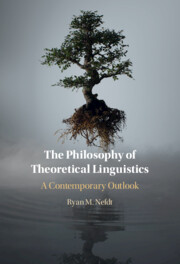811 results
7 - Computational Approaches to Language
-
- Book:
- The Philosophy of Theoretical Linguistics
- Published online:
- 25 April 2024
- Print publication:
- 02 May 2024, pp 157-182
-
- Chapter
- Export citation
9 - Conclusion
-
- Book:
- The Philosophy of Theoretical Linguistics
- Published online:
- 25 April 2024
- Print publication:
- 02 May 2024, pp 205-206
-
- Chapter
- Export citation
1 - Introduction
-
- Book:
- The Philosophy of Theoretical Linguistics
- Published online:
- 25 April 2024
- Print publication:
- 02 May 2024, pp 1-22
-
- Chapter
- Export citation
Index
-
- Book:
- The Philosophy of Theoretical Linguistics
- Published online:
- 25 April 2024
- Print publication:
- 02 May 2024, pp 229-232
-
- Chapter
- Export citation
8 - Language and Evolution
-
- Book:
- The Philosophy of Theoretical Linguistics
- Published online:
- 25 April 2024
- Print publication:
- 02 May 2024, pp 183-204
-
- Chapter
- Export citation
References
-
- Book:
- The Philosophy of Theoretical Linguistics
- Published online:
- 25 April 2024
- Print publication:
- 02 May 2024, pp 207-228
-
- Chapter
- Export citation
6 - Signs, Sounds, Action!
-
- Book:
- The Philosophy of Theoretical Linguistics
- Published online:
- 25 April 2024
- Print publication:
- 02 May 2024, pp 137-156
-
- Chapter
- Export citation
Tables
-
- Book:
- The Philosophy of Theoretical Linguistics
- Published online:
- 25 April 2024
- Print publication:
- 02 May 2024, pp viii-viii
-
- Chapter
- Export citation
Contents
-
- Book:
- The Philosophy of Theoretical Linguistics
- Published online:
- 25 April 2024
- Print publication:
- 02 May 2024, pp v-vi
-
- Chapter
- Export citation
Acknowledgements
-
- Book:
- The Philosophy of Theoretical Linguistics
- Published online:
- 25 April 2024
- Print publication:
- 02 May 2024, pp xi-xii
-
- Chapter
- Export citation
Frontmatter
-
- Book:
- The Philosophy of Theoretical Linguistics
- Published online:
- 25 April 2024
- Print publication:
- 02 May 2024, pp i-iv
-
- Chapter
- Export citation
Preface
-
- Book:
- The Philosophy of Theoretical Linguistics
- Published online:
- 25 April 2024
- Print publication:
- 02 May 2024, pp ix-x
-
- Chapter
- Export citation
2 - What Is a Possible Human Language?
-
- Book:
- The Philosophy of Theoretical Linguistics
- Published online:
- 25 April 2024
- Print publication:
- 02 May 2024, pp 23-49
-
- Chapter
- Export citation
5 - Context and Pragmatics
-
- Book:
- The Philosophy of Theoretical Linguistics
- Published online:
- 25 April 2024
- Print publication:
- 02 May 2024, pp 108-136
-
- Chapter
- Export citation
3 - Syntactic Metatheory
-
- Book:
- The Philosophy of Theoretical Linguistics
- Published online:
- 25 April 2024
- Print publication:
- 02 May 2024, pp 50-79
-
- Chapter
- Export citation
4 - The Science of Semantics
-
- Book:
- The Philosophy of Theoretical Linguistics
- Published online:
- 25 April 2024
- Print publication:
- 02 May 2024, pp 80-107
-
- Chapter
- Export citation
Figures
-
- Book:
- The Philosophy of Theoretical Linguistics
- Published online:
- 25 April 2024
- Print publication:
- 02 May 2024, pp vii-vii
-
- Chapter
- Export citation

The Philosophy of Theoretical Linguistics
- A Contemporary Outlook
-
- Published online:
- 25 April 2024
- Print publication:
- 02 May 2024
Impact of a pharmacy-driven MRSA nares screening protocol on vancomycin discontinuation in a tele-antimicrobial stewardship model
-
- Journal:
- Antimicrobial Stewardship & Healthcare Epidemiology / Volume 4 / Issue 1 / 2024
- Published online by Cambridge University Press:
- 22 April 2024, e56
-
- Article
-
- You have access
- Open access
- HTML
- Export citation
Chapter 27 - Business Considerations in Mass Gathering Medicine
-
-
- Book:
- Mass Gathering Medicine
- Published online:
- 11 April 2024
- Print publication:
- 18 April 2024, pp 401-405
-
- Chapter
- Export citation



